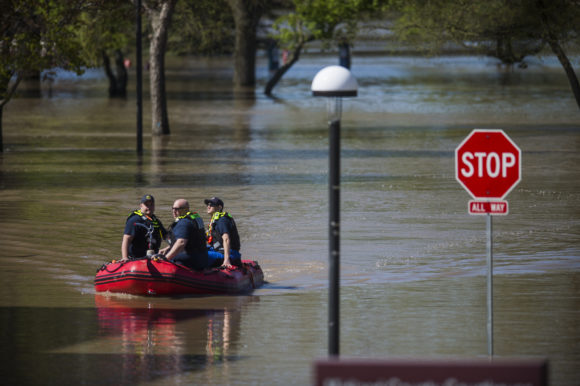June 24, 2020 INSURANCE JOURNAL

Severe weather outbreaks across the United States, with a lot of hailstorm damage, resulted in another costly month for insurers as a significant proportion of the US$4 billion economic cost was covered by insurance, according to Aon’s monthly Global Catastrophe Recap report.
One of the more severe outbreaks on May 4-5 hit the Plains, Midwest and Southeast, with impacts felt the most in parts of Kansas, Arkansas, Missouri, Tennessee and South Carolina, said the report. Most damage was due to straight-line winds, causing estimated economic losses of more than US$975 million, with 75% of the costs insured.
Michigan Sues Owner of Failed Dams, Seeks Compensation for Destruction
Top 100 Cities: 6 in 10 Homes in High-Risk Flood Zones Lack Flood Insurance
Evacuations in Michigan as Dams Break, Flooding Hits Midwest
Record rains and flooding on May 16-21 led to the failure of two dams near Midland, Mich. on May 19, which caused historic flooding along the Tittabawassee River. Additional flooding occurred within the Chicago metro region. Total economic losses were estimated well into the hundreds of millions of U.S. dollars. While most of the wind and hail-related damage was expected to be insured, low National Flood Insurance Program (NFIP) coverage in areas hard hit by flooding meant most of that damage was likely to be uninsured.
In other parts of the world, damages were often high, but there was little insurance protection to pay for them. For example, the report reveals that Cyclone Amphan, which swept across India, Bangladesh, and Sri Lanka during the month, killed at least 133 people – 103 in India, 26 in Bangladesh, and four in Sri Lanka – and injured more than 1,200 others. Governments of India and Bangladesh estimated that nearly three million homes had been damaged or destroyed, along with vast areas of agriculture and infrastructure.
The government in West Bengal, India, expected total economic losses to exceed INR1.0 trillion (US$13.5 billion), while officials in Bangladesh noted damage costs nearing BDT127 billion (US$1.5 billion). Most of the damage was expected to be uninsured.
“The vulnerabilities of infrastructure were amplified by Cyclone Amphan’s widespread effects in India and Bangladesh during May. The storm brought extensive coastal and inland flooding, in addition to hurricane-force wind gusts, which put a further spotlight on the need for future investments in modernizing coastal barriers, embankments, and the electrical grid in storm-prone areas around the world,” said Michal Lörinc, catastrophe analyst within Aon’s Impact Forecasting team, in a statement.
The Aon report indicated that hailstorms had a big role in U.S. losses during the month. Some of the storms included:
Severe weather on May 2-3. Parts of the central and southern sections of the U.S. were affected, causing total economic losses of an estimated US$650 million with insurers covering nearly US$500 million of that amount. The hardest-hit areas were in parts of Oklahoma, Missouri, Arkansas, and Tennessee where large hail – up to the size of softballs – and damaging straight-line winds approaching 80 mph (130 kph) were recorded.
Powerful thunderstorms on May 7-8. Hail (larger than baseballs) and straight-line wind (topping 60 mph), caused damage in Texas (especially in the Panhandle), Oklahoma, Kansas, and Louisiana. Economic losses were estimated at nearly US$150 million, with insurance covering most of the damages.
Severe weather on May 13-15. Twelve states saw damage from large hail (up to the size of baseballs), straight-line winds (topping 70 mph), flooding rains and isolated tornadoes. Some of the most extensive damage was reported in New York and Massachusetts. Total economic and insured losses were estimated in the hundreds of millions of dollars.
Severe weather and major flooding May 16-21. The central and eastern U.S. saw thunderstorms with reports of tornadoes, large hail, and straight-line winds. Extensive property damage hit areas from Texas to Ohio to Florida (which included hail larger than baseballs in Seminole County, Fla.)
Major hailstorm on May 27. Extensive severe weather was reported across Texas and elsewhere in the Southeast on May 27-28. Supercells produced swaths of large and significant hail, notably near San Antonio. Hailstones approaching 2.50 inches (6.4 centimeters) were reported. Total economic losses were expected to top US$1 billion, with most of those costs likely to be covered by insurance.
Further global natural hazard events during the month of May include:
Tropical Storm Amanda affected parts of Central America and caused 33 fatalities. Its remnants later evolved into Tropical Storm Cristobal in the Gulf of Mexico in early June.
Notable hail, wind and flood-related effects occurred in Spain, France, Germany, the Czech Republic and Poland on May 9-11. Aggregated economic losses were expected to be in the tens of millions of euros.
Typhoon Vongfong became the first named storm of the 2020 Pacific Typhoon Season and hit the Philippines on May 14-15. Nearly 50,000 homes were damaged or destroyed.
Seasonal flooding continued in Eastern Africa, leading to an additional 30 fatalities in Kenya on May 4-6. Kenyan government officials reported that the seasonal death toll rose to at least 237 since late March. At least 29 out of 47 counties in Kenya were affected, displacing around 100,000 people.
Strong winds and heavy rains swept across western Australia on May 25. The event occurred as remnants of Tropical Cyclone Mangga interacted with a cold front, later hitting southwestern Australia. Widespread power outages ensued, as power was cut to nearly 62,000 homes across the state. No human casualties were reported, and impact on property and motor was subject to further assessment.
Source: Aon’s Impact Forecasting
Photograph: Law enforcement officers patrol downtown Midland, Mich. in a rescue boat on Thursday, May 21, 2020. Severe flooding was caused by dam failures upstream. Photo credit: Katy Kildee/Midland Daily News via AP.
No comments:
Post a Comment